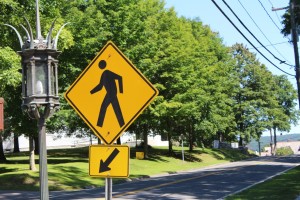Historical Society Produces Walking Tour Map
Unfolding Norfolk’s Past
By Lindsey Pizzica Rotolo

A lamp by Augustus Saint-Gaudens at the start of the Norfolk Historical Society’s new map-guided walking tour.
Just in time for the high season, the historical society has produced a walking tour map of town. The map is rather extensive—including a grand total of 50 places of historical interest all within one mile of the town center.
The tour is intended to take about an hour and begins and ends at 10 Station Place, the original railroad station building. The map includes dozens of photographs, old and new (the new taken by Christopher Little, the old from the historical society’s archives). Financed by the AKC Fund, “Walking Historical Norfolk” has been mass-produced and copies can be found at Town Hall, the library, the historical museum, the Manor House and Mountain View Inn.
As all Norfolk residents know, the town was largely shaped by the Battell family, but many may not realize that the majority of the buildings in our historic district are here because of them alone. The map provides detailed accounts of each.
Not ending there, the map invites participants outside the town’s relatively small historic district to observe the dozens of other places of historical interest that lie to the north. Given the space confines, the map is remarkable in the depth of its content. It is truly a history lesson, providing readers (and walkers) with a significant understanding of Norfolk’s past—from its beginnings in the mid-1700’s through the twentieth century.
The map highlights 11 places of interest along Maple Avenue, one on Mills Way, three on Shepard Road and 12 on North Street, in addition to the 23 historically significant places downtown and surrounding the village green. Participants are encouraged to drive in just two places along the way, up North Street to Center Cemetery and the Haystack tower and through the Stoeckel estate.
Seven nationally-known architects are responsible for buildings in Norfolk’s downtown area: the library, Church of Christ, Battell Chapel, Eldridge Gymnasium (Town Hall), The Alders (the Manor House), Church of the Transfiguration, Church of the Immaculate Conception, Village Hall (Infinity Hall) and the Royal Arcanum Building. A brief history of each building’s genesis is included in the map.
While designed to bring visitors’ attention to the fact that “the town retains the architectural charm and ambience that were created around the turn of the twentieth century when Norfolk was a popular summer resort,” the map offers plenty of information that will also educate longtime residents.
Photo by Wiley Wood.
